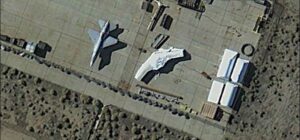A commercial satellite has spotted a mysterious Unmanned Aerial Vehicle parked at Lockheed Martin’s Skunk Works facility in Palmdale, California. The orbital snapshot was reportedly taken on Dec. 4, but became public only last week in a blog post by George Kaplan, a self-described “open-source” intelligence analyst who relies solely on publicly available imagery.
Wrapped in what appears to be plastic, parked at an angle next to an F-16 on a concrete apron near the U.S. Air Force’s top-secret Plant 42, the supposed UAV shares the basic dimensions and overall flying-wing shape of many of today’s jet-powered drones. Using the 50-foot-long F-16 as a yardstick, it seems the UAV has a wingspan of around 60 feet.
Beyond that, anything we say about the “new” drone is conjecture. We emailed a Lockheed spokesperson asking for comment, but the company does not habitually comment on the goings-on at the Skunk Works, whose other products have included the F-117 stealth fighter and the U-2 and SR-71 spy planes.
That said, the mystery drone’s wingspan seems to match the consensus figure for the wingspan of Lockheed’s secretive RQ-170 Sentinel, also a Skunk Works design. The stealthy RQ-170 was first spotted at Afghanistan’s Kandahar Air Field in 2007. Two years later the Air Force confessed to operating a small number of Sentinels for “reconnaissance and surveillance.”
On Dec. 4, coincidentally the same day Kaplan’s snapshot was taken, Iranian forces captured a crashed Sentinel near the Iran-Afghanistan border, provoking a diplomatic row. As revealed by the Iranians, the crashed Sentinel’s maintenance logs indicated that it, or at least parts of it, had been sent back to Palmdale from Afghanistan for maintenance. Noted aviation journalist David Cenciotti connected these dots in his own search for the mystery drone’s identity. “I think it’s a Sentinel,” he tells Danger Room. “A damaged one.”
But the nameless UAV could also be the long-rumored, but previously unseen, prototype for the stealthy P.420 drone bomber that Lockheed patented way back in 1997. At least, that’s what the reporters at Flight think. Very little is known about the P.420, though it’s possible some of the old drone’s design elements made it into the operational RQ-170.
Less likely, the shrouded ‘bot could be related to Lockheed’s undisclosed new design for the Navy’s Unmanned Carrier Launched Airborne Surveillance and Strike drone fighter competition. Four companies — Lockheed, Boeing, Northrop Grumman and General Atomics — are competing to build potentially hundreds of ship-launched UCLASS strike drones for service in the 2020s. Northrop’s entry will almost certainly be based on its X-47B demonstrator, and Boeing’s on its similar X-45C. Both the X-47B and the X-45C are flying wings with spans between 40 and 60 feet. It wouldn’t be surprising if Lockheed’s proposed robotic fighter were similar, and therefore a close match with the mystery drone seen at Palmdale.
But a brand-new UAV prototype would never be left outside in full view of satellites, according to two drone-industry insiders who spoke to Danger Room on condition of anonymity. “If it had any value it wouldn’t be sitting there like it is,” one insider says.
Maybe not, but the Pentagon and its industrial partners don’t have the best track record keeping its secret drones such as the RQ-170 under wraps. Just ask the Iranians. It’s not inconceivable that Lockheed is putting the finishing touches on a new, top-secret robotic warplane — and accidentally left it out in the open for the world to see.
Source: WIRED



















